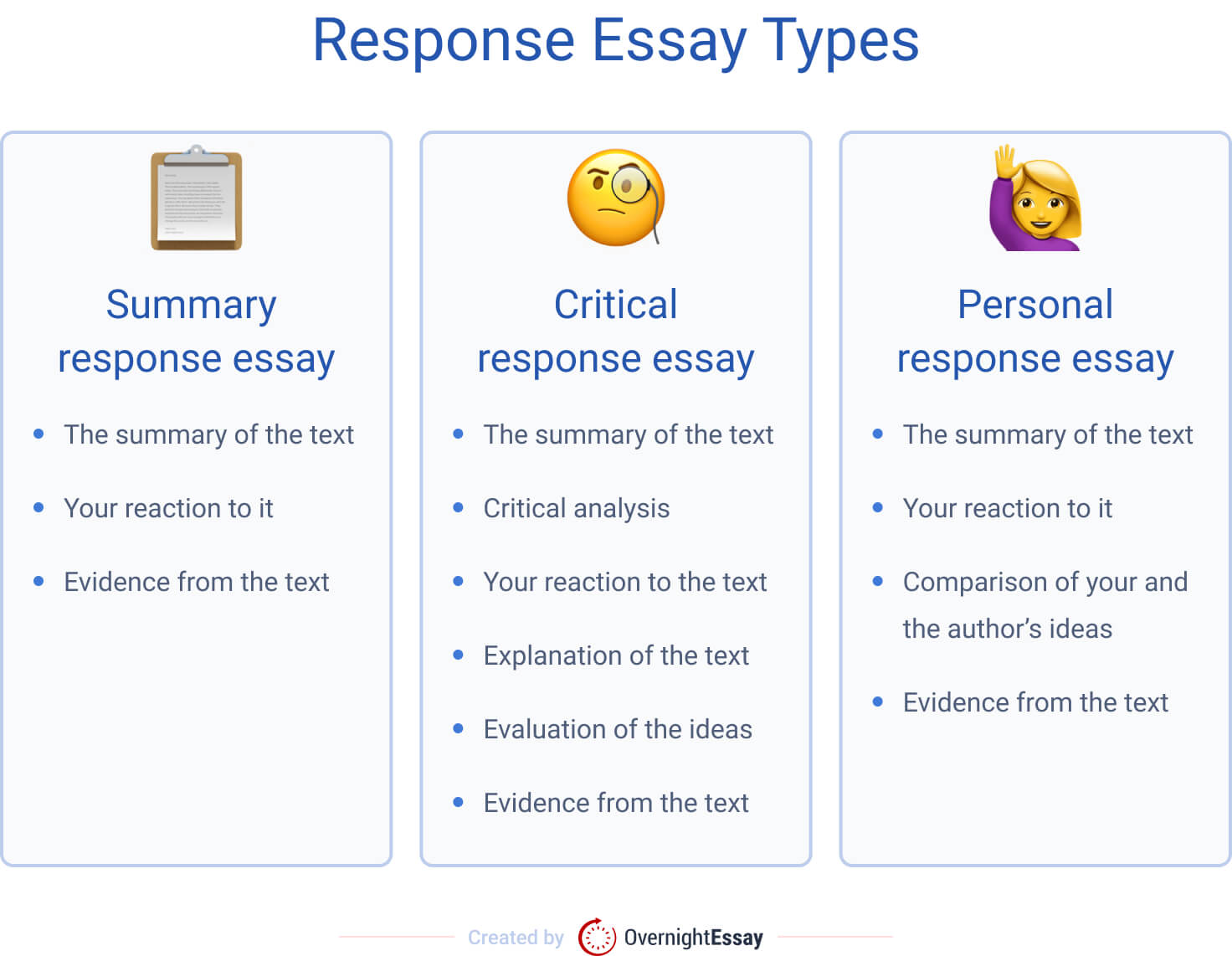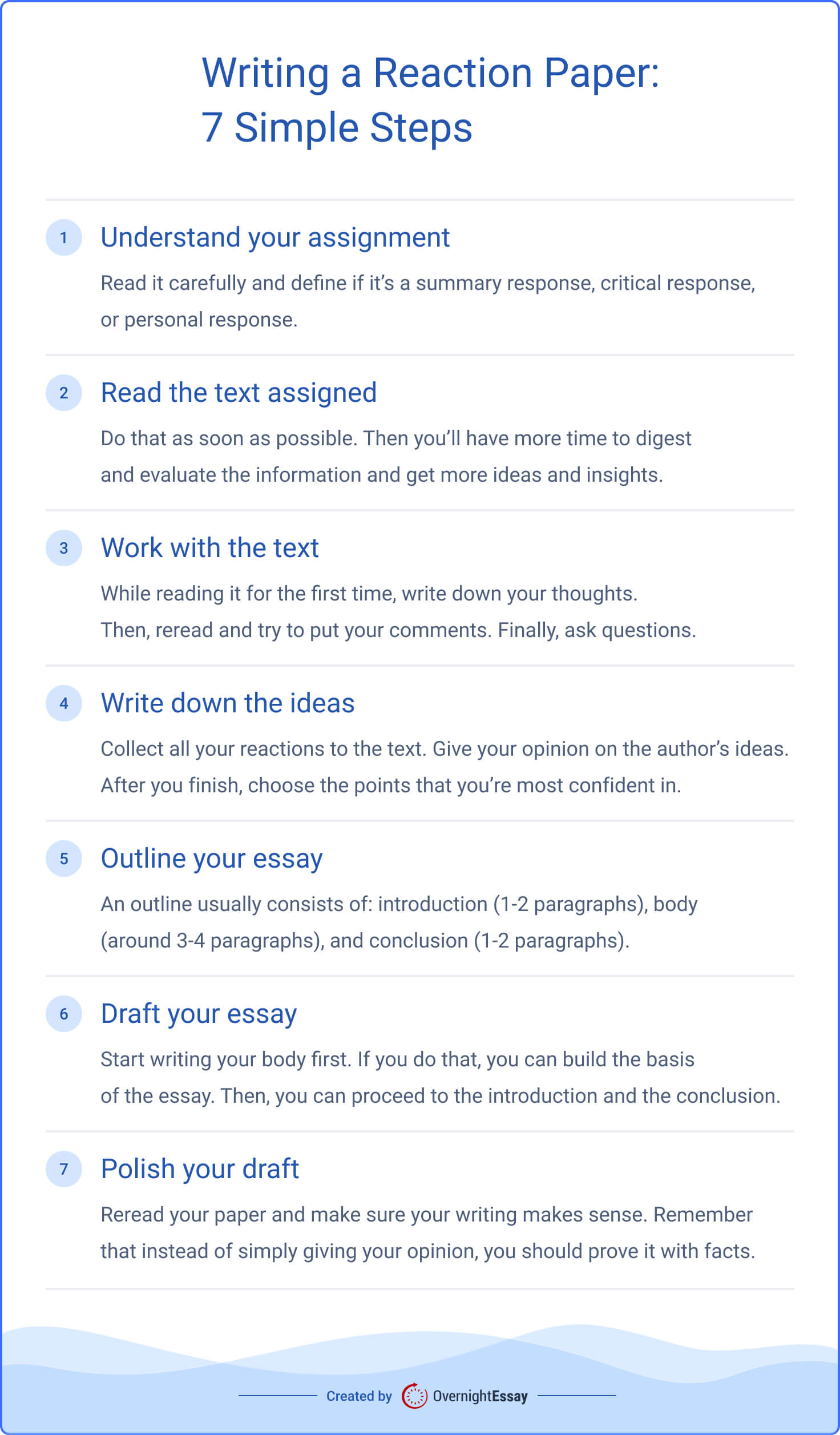
A response or reaction paper is a form of a written assignment that includes a summary, analysis, and personal response to a piece of literary work (it can also be about an article, a movie, a story, a song, or a video).
This essay aims not only to express your thoughts and ideas but to prove them with facts and evidence. In this article, you will learn what kinds of response papers exist and what the difference between them is. You will also find 7 simple steps to writing a reaction paper and a simple reaction paper example.
❓ What Is a Response Paper?
The below guide breaks down the process of writing a response essay from scratch.
So, what is a response paper?
A response paper (or a reaction paper) offers a personal opinion on the given text. Since you need to show your opinion, it is important to state it based on your reaction and experience. It would help if you made it logical as well.
This kind of paper is usually assigned to students who work with scientific or literary texts in college. Since most majors involve these, almost every student has to write a response paper at some point. For example, a novel reaction paper or a political science reaction paper.

The three main types of response essays are:
- Summary response essay
- Critical response essay
- Personal response essay
Let’s dive deeper into each of them.
Summary Response Essay
A summary response essay is a sort of reaction paper. It consists of two parts:
- the summary of the piece of work,
- your response to it.
It is usually around five paragraphs long.
The first part of the essay consists of a summary. Here, you need to mention the author, publisher, and publishing date. Then, summarize the piece of work and be sure to cover all the key points. You also should include some citations from the story.
By the way, we offer a free summarizing tool if you need to make a summary quickly.
Do not put your personal opinion in the first part. The second part of your essay is where you need to express your impression and give your reaction.
Critical Response Essay
A critical response essay is a form of reaction paper. It is more detailed and includes critical analysis. This essay aims to show your critical thinking and the ability to express your opinion.
To write a good critical response, you need to:
- analyze the text,
- interpret it,
- summarize it.
You may think that critical response requires only analyzing the drawbacks of the text. However, the crucial part here is that you need to:
- analyze the author’s idea,
- think of its strengths and weaknesses,
- find evidence supporting your point,
- explain the evidence.
Personal Response Essay
A personal response essay is also a kind of a response paper. Here, you need to analyze the piece of writing and give a personal opinion based on your own experience. The important part is that you need to compare the author’s ideas with yours.
This kind of assignment aims to express your personal beliefs from a philosophical and logical point of view. You should prove it using the evidence from the given text.
The personal response essay requires your critical thinking and analytical skills. Try to write down all your thoughts and reactions as you read the text.
📎 Response Essay: Summary vs. Critical vs. Personal
Even though all three types of the essay are different, they have a lot in common. Before you begin writing your essay, make sure to read the guideline carefully.
Let’s break down what we’ve learned so far:
👣 How to Write a Reaction Paper? 7 Simple Steps
A good reaction paper offers a thorough analysis, reasonable claims, and a good structure.
Here’s the detailed step-by-step guide on how to write a reaction paper. You’ll find out what to include in the introduction, body, and conclusion with these simple steps.

Step 1: Understand Your Assignment
You must be wondering how to start your reaction paper.
Before starting your writing, you need to understand what kind of paper you need to write. Read your assignment carefully and define if it’s a summary response, critical response, or personal response.
The format of your essay depends on what kind of assignment you have. After defining the type of paper you need to write, you can manage your time effectively and start preparing an outline.
Note that you can use first-person point of view in your response essay.
Step 2: Read the Text Assigned
A lot of people don’t start reading the assigned text until the very last moment. Here’s why it is entirely wrong.
If you read the assigned text as soon as possible, you’ll have more time to digest and evaluate the information and get more ideas and insights.
Sometimes, your opinion might change over time. That’s why you should try giving yourself more time to reflect on what you’ve read.
Moreover, it is necessary to read the text more than once to get a better understanding. Remember that you need to summarize it, so try reading it as many times as you can.
Simply giving your opinion on the piece of writing is not enough. You should analyze it, evaluate, and combine all the ideas you get from it. That’s why you need to read it very carefully.
Step 3: Work with the Text
There are also techniques for working with the text more effectively.
While reading the text for the first time, try to write down the rough draft of your thoughts.
Then, reread and try to put your comments. It will be much easier to find the correct quote or your initial reaction if you do this. Moreover, it can save a lot of time later.
Finally, ask questions. Think of the questions that can uncover more details about the text.
Some of the questions you can ask:
- What are the strong and weak parts?
- What are the author’s main ideas?
- How does the author support their claims?
- How are the topics from the text related to what we have discussed in class?
By answering these questions, you can understand the author and the text better.
Step 4: Write Down the Ideas
Now, you need to collect all your ideas and reactions by writing them down. Give your opinion on the author’s ideas and explain their point of view. Here, you need to either agree or disagree with the author.
After you finish, choose the points that you’re most confident in. These will be the basis of your essay.
After that, try to decide on your point of view. Since analyzing is the key, try asking questions about the text. Why did the author write this story from this angle? What connection does it have to real life? You can evaluate the text by answering these questions.
Now, you should collect all the points that you’ve made and write down your thesis statement. The thesis statement should contain the claim that you’ll prove in your essay. Try to summarize all your observations and ideas into one statement.
Need help with formulating a thesis statement? You are welcome to use our free thesis maker!
Step 5: Outline Your Response Paper
How to outline a response paper? Well, it depends on its type, but usually, an outline consists of:
- Introduction (1-2 paragraphs)
- Body (around 3-4 paragraphs)
- Conclusion (1-2 paragraphs)
Here’s the sample of what you can write in each part:
Step 6: Write Your Draft
Now, let’s start writing your draft.
Writing a draft is the essential part of your essay writing. It is better to start writing your body first. If you do that, you can build the basis of the essay. Then, you can proceed to the introduction and the conclusion.
Structure Your Arguments
Start your paragraphs with the topic sentences. After that, state the author’s idea and your reaction to it. Keep in mind that you can either agree or disagree with the author. So, it would be best to show how your ideas correspond with theirs or how they contrast.
Don’t simply write, “I disagree with the author because I don’t like his idea.” You should sound logical and always be ready to prove your claim.
Some of the templates you can use in your paragraph:
- In my opinion
- The author seems to
- I did not like / I liked
- My favorite / least favorite part was… because
- I believe
- The reader can conclude that
- I agree/ disagree with the author because
- I can’t understand the connection to
- I felt that
Write Your Introduction & Conclusion
Let’s now dive deeper into the introduction and conclusion parts.
First of all, in your introduction, you should mention the author’s name, the title of the text, and the publisher if it’s required. The last sentence should be your thesis statement.
The introduction should grab your reader’s attention, so don’t make it too long and complicated.
Some of the introduction and conclusion ideas:
Step 7: Polish Your Draft
Now, it’s time to polish your essay. Follow these steps to do it.
Reread your paper and make sure your writing makes sense. Remember that instead of simply giving your opinion, you should prove it with facts.
Some teachers require your personal opinion in conclusion, but some may also allow it to be in the body parts. So, if there are any confusing parts of the assignment, make sure to ask your teacher.
If you’ve discussed some topics in class, it may be a good idea to connect them to the ideas in your paragraph.
Remember to keep it short. Your reaction paper should be from 500 words up to 5 pages long.
Proofread it carefully and check your grammar, spelling, and punctuation.
Double-check the guideline and make sure you understand the meaning of the assignment correctly.
Now, you are ready to submit your response paper.
👀 Response Paper Example
If you’re still wondering how to write a reaction paper, here’s a sample. It is A Rose for Emily response paper with a marked outline.
A Rose for Emily Response Paper
📝 Reaction Paper Example
We’ve previously explored how to craft a response paper for a book, but what about scientific writings? When it comes to reacting to non-fiction papers, a well-structured response typically includes a concise summary of the work, your response to the findings with references to concepts learned in class, and a thoughtful conclusion. Here’s an example of how to approach a psychology reaction paper.
Psychology Reaction Paper Example
Now you’re all set to write your response paper. Share your lifehacks in the comments below.